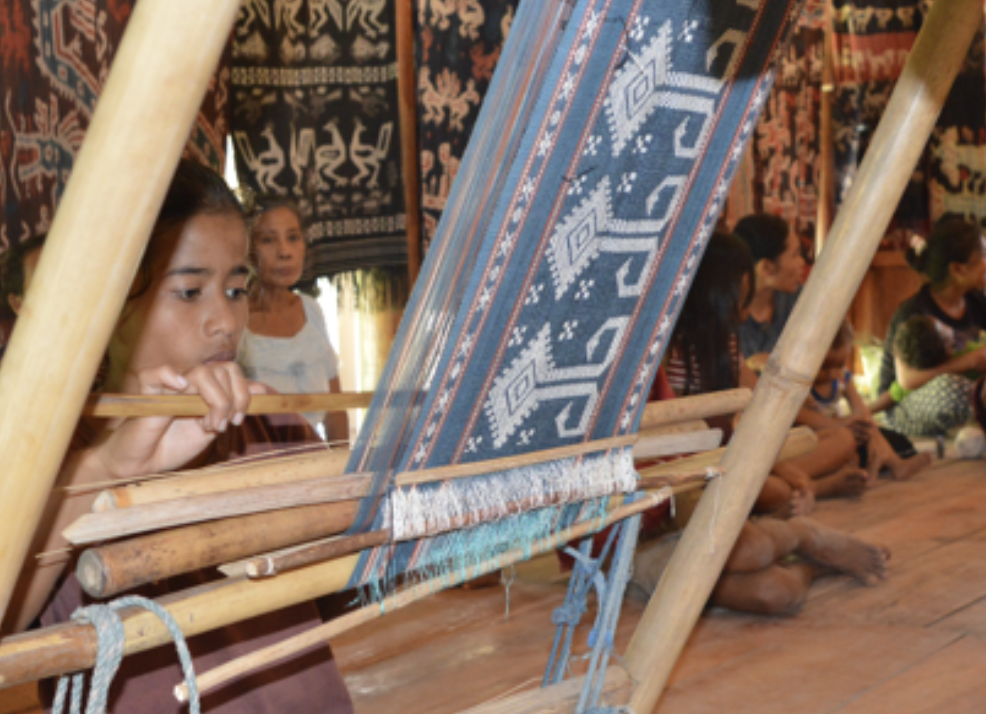Abstract
This paper aims to show that cultural materials, which are often considered cultural and area-bounded, turn out to have a diversity that depends on each place's social, cultural, economic, and geographical dynamics. This paper will focus on cultural materials in the form of Sumba weaving cloth. This paper is based on research with a qualitative approach, especially with observation methods in several weaving centers in Sumba and in-depth interviews with weaving artisans. The result of this study is that Sumba weavings cloth has local characteristics that depend on environmental potential, social, economic, historical, and cultural aspects, as well as the knowledge of its weavers from each region in Sumba. This diversity is reflected in the manufacturing techniques, coloring techniques, and various motifs adorn the weaving process.
References
Adams, M. (1972). Classic and Eccentric Elements in East Sumba Textiles. The Bulletin of the Needle and Bobbin Club, New York.
Adams, M. J. (1973). Structural Aspects of a Village Art 1. American Anthropologist, 75(1), 265–279.
Adams, M. J. (1974). Symbols of the organized community in East Sumba, Indonesia. Bijdragen tot de Taal-, Land-en Volkenkunde, (2/3de Afl), 324-347.
Adams, M. (1981). Instruments and songs of Sumba, Indonesia: A preliminary survey. Asian Music, 13(1), 73–83.
Allerton, C. (2007). The secret life of sarongs: Manggarai textiles as super-skins. Journal of Material Culture, 12(1), 22–46.
Anas, B. Design Metamorphosis in the Ikat Cloth of East Nusa Tenggara: East Sumba Hinggi Motifs. Past, Present, and Future. In Proceedings of The International Conference on Traditional Textiles of Indonesia: Today and In The Future (p. 15).
Aulia, D., & Ikhwana, A. (2012). Planning a silk weavings business development strategy with a balanced scorecard method approach (Case study in the Three Sons Silk Factory). Journal of Calibration, 10(1).
Central Statistics Agency (2021). Rainfall Data in Indonesia in 2021.
Budhi, S. (2015). Bugis Pagatan: Migration, Adaptation, and Identity. IOSR Journal Of Humanities And Social Science (IOSR-JHSS), 20(5), 71–78.
Danesi M. (2004). Messages, signs, and meanings: A basic textbook in semiotics and communication. Toronto, Ontario: Canadian Scholars' Press.
Demmalino, E. B., Ibrahim, T., & Lumoindong, Y. (2019). PANRITA LOPI: Cultural Value and Religiosity Behind Professionalism of Making Pinisi Boats in Bulukumba. ETHNOSIA: Journal of Indonesian Ethnography, 1-19.
Efianingrum A. (2011). Batik as an establishment medium of local identity and national character (Proceeding of Seminar on Batik).
Feinberg R. A., Mataro L., Burroughs W. J. (1992). Clothing and social identity. Clothing and Textiles Research Journal, pp. 11, 18-23.
Forshee, J. (2001). Between the folds: Stories of cloth, lives, and travels from Sumba. University of Hawaii Press.
Forshee, J. (2006). Culture and customs of Indonesia (Vol. 88). Westport CT: Greenwood Press.
Forth, G. L. (1981). Rindi: an ethnographic study of a traditional domain in eastern Sumba. In Rindi. Brill.
Geertz, H. (1965). Comment on PE Josselin de Jong, an interpretation of agricultural rites in Southeast Asia. Journal of Asian Studies, 24(2), 294–297.
Hamid, N. A. (2022). WORK ETHIC OF WOMEN TRADERS (Case Study Of Buton Women As Pajibujibu And Papalele On The West Coast Of Seram Island, West Seram Regency, Maluku)= WORK ETHIC OF WOMEN TRADERS (Case Study Of Buton Women As Pajibujibu And Papalele On The West Coast Of Seram Island, West Seram District, Maluku) (Doctoral dissertation, Hasanuddin University).
Holmgren, R. J., & Spertus, A. E. (1989). Early Indonesian textiles from three island cultures: Sumba, Toraja, Lampung. Metropolitan Museum of Art.
Hoskins, J. (2002). Review of Between the Folds: Stories of Cloth, Life, and Travels from Sumba.
Iswanto, S., Kusnafizal, T., Kamza, M., & Haikal, M. (2022). Minangkabau migration to Tanah Gayo, Aceh: History, Factors, and Impacts. ETHNOSIA: Journal of Indonesian Ethnography, 29-41.
de Jong, W., & Kunz, R. (2016). The Shoulder Cloth wound semba: Being (Trans) Local in Flores.
de Jong, W., & Kunz, R. (2019). Striking Patterns: Contemporary Ikat Design and Its Future. TEXTILE, 17(3), 289-295.
Josselin de Jong, J. D. (1935). De Maleische Archipel als ethnologisch studieveld. Leiden: Ginsberg.
Krisnawati, E., Sunarni, N., Indrayani, L. M., Sofyan, A. N., & Nur, T. (2019). Identity exhibition in batik motifs of Ebeg and Pataruman. Sage Open, 9(2), 2158244019846686.
Martini, D., Sutrisno, B., & Kurniawan, K. (2019). Weaving Sasak in Indonesian Legal Discourse: From Cultural Heritage to Local Economic Booster. PADJADJARAN JOURNAL OF LAW, 6(3), 576-593.
Muzaqii, F. et al. (2018). A New History of Fighting. Directorate of belief in God Almighty and Tradition of the Ministry of Education and Culture.
Nurcahyani, L. (2018). Sintang Ikat Weavings Product Development Strategy. Journal of Education and Culture, 3(1), 56–72.
Pollock, I. (2012). Ancient emblems, modern cuts: weaving and the state in southeastern Indonesia.
Prayitno, T. (2020). Get to know the National Products of Batik and Weaving. Alprin.
Pulubuhu, D., & Hasbi, H. (2020). Work Ethic of Butonese Women in The West Coast of Seram Island, Maluku. ETNOSIA: Journal of Indonesian Ethnography, 332-348.
Setiawan, B., & Suwarningdyah, R. N. (2014). The development strategy of ikat kupang weaving in east nusa tenggara province. Journal of Education and Culture, 20(3), 353-367.
Sila, I. N. (2013). Aesthetic Study of Ornamental Variety of Songket Jinengdalem Weaving, Buleleng. Journal of the Social Sciences and Humanities, 2(1).
Suadnyana, I. B. P. E. (2020). Cagcag Weavings Cloth at the Manusa Yadnya Ceremony in Sangkaragung Village, Jembrana Regency. Jnanasidanta, 2(1), 51-60.
Sudianto, A., & Sadali, M. (2018). Application of Geographic Information System (GIS) in Mapping Weavings and Pottery Crafts to Increase the Potential of Handicrafts in East Lombok Regency. Infotech: Journal of Informatics and Technology, 1(2), 71-78.
Sunarya, Y. Y. (2016). Identity of Indonesia textile craft: Classic to modern batik. Chapter of Asia Craft-Tech Korea ACC Book, 21-30.
Wijaya, K., & Permana, A. Y. (2018, December). Textile Tourism Image as an Identity of Cigondewah in Bandung City. In IOP Conference Series: Earth and Environmental Science (Vol. 213, No. 1, p. 012012). IOP Publishing.

This work is licensed under a Creative Commons Attribution-NonCommercial 4.0 International License.
Copyright (c) 2022 ETNOSIA : Jurnal Etnografi Indonesia





